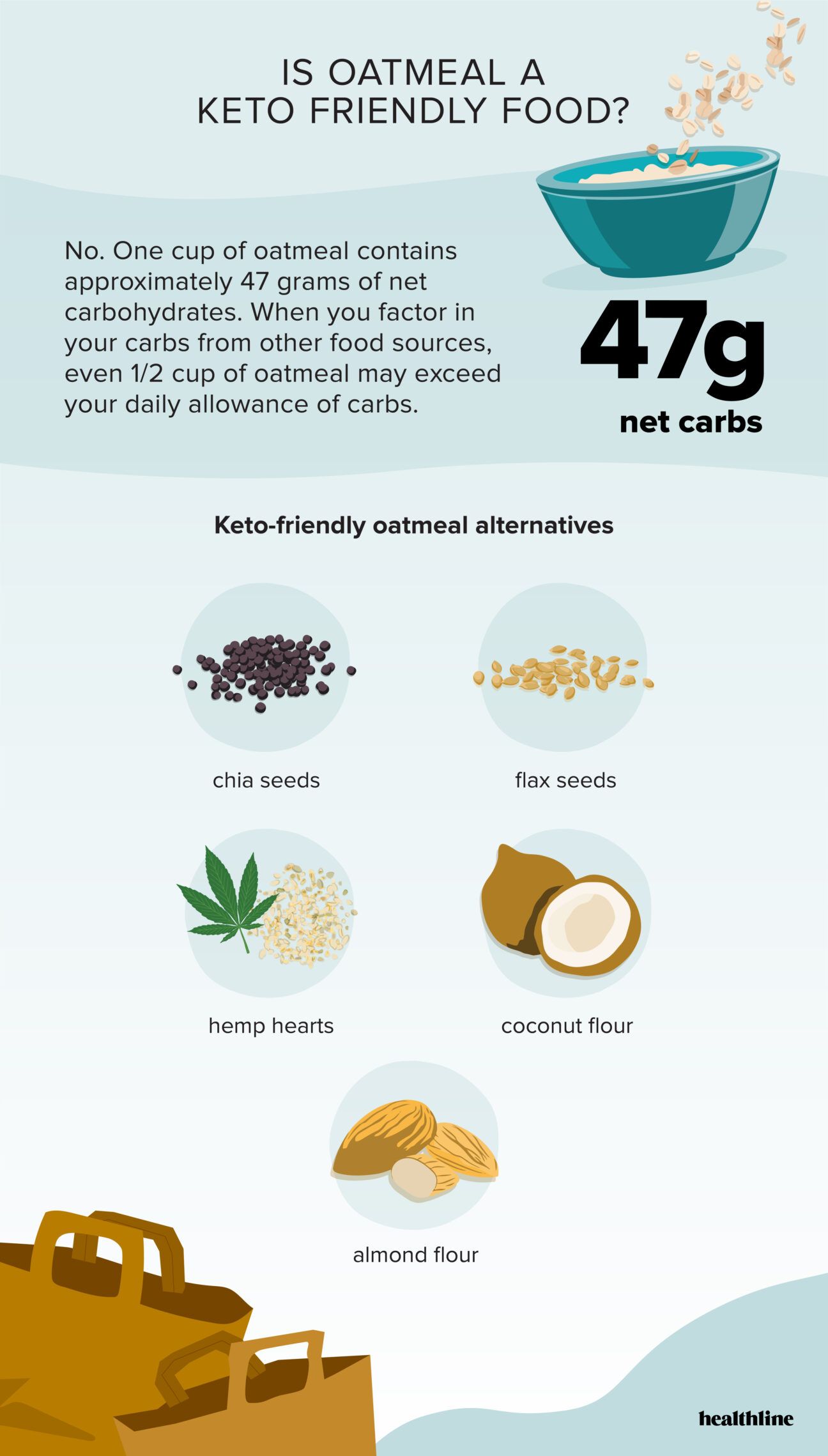Oatmeal is often touted as a quintessential health food, being rich in dietary fiber and essential nutrients. But when it comes to the strict carbohydrate restrictions of a ketogenic diet, many find themselves questioning its compatibility. Could something so nutritious really be at odds with keto principles?
Traditionally, oatmeal has been a staple for those seeking to improve heart health, thanks to its beta-glucan content. Yet, with approximately 27 grams of carbohydrates per serving, it poses a challenge for maintaining ketosis. Instead, some keto enthusiasts have turned to alternatives like cauliflower or flaxseed oatmeal, offering similar texture without the carbohydrate overload.

Defining The Keto Diet
The keto diet, short for ketogenic diet, is a low-carb, high-fat eating plan. Its main goal is to shift the body’s metabolism from burning carbohydrates to burning fats. This process, known as ketosis, helps in reducing blood sugar and insulin levels.
Following a keto diet means significantly reducing carb intake. Instead, you consume healthy fats and moderate protein. This change forces the body to use fat as its primary energy source.
Common foods in a keto diet include meats, fish, eggs, butter, and oils. Non-starchy vegetables like broccoli and spinach are also staples. By avoiding high-carb foods, the body stays in a state of ketosis.
Many people turn to the keto diet for weight loss and improved energy. Others find it helpful for managing certain medical conditions like epilepsy. The diet’s strict rules can be challenging but offer various health benefits.
Oatmeal and Its Nutritional Composition
Oatmeal is not only delicious but also packed with nutrients. It is known for its high fiber content, which is great for digestion. Additionally, it provides essential vitamins and minerals.
One key component of oatmeal is beta-glucan. This type of soluble fiber helps lower cholesterol. Moreover, it can boost your immune system.
Oatmeal is also a good source of protein, though not as high as animal products. It contains important minerals like iron, magnesium, and zinc. These nutrients support overall health and energy levels.
However, oatmeal is relatively high in carbs, with about 27 grams per half-cup serving. This makes it challenging for keto dieters, who aim to minimize carb intake. Exploring alternatives might be necessary for those following a keto plan.
Fiber Content in Oatmeal
Fiber is crucial for digestive health. Oatmeal contains both soluble and insoluble fibers. Soluble fiber, like beta-glucan, can help reduce blood sugar spikes.
Insoluble fiber aids in digestion by promoting regular bowel movements. Together, these fibers make oatmeal a digestive powerhouse. Eating oatmeal regularly can help you feel full longer.
For those not on a keto diet, adding fruits to oatmeal can further boost its fiber content. However, those following keto should avoid high-carb fruits. Low-carb toppings like nuts and seeds can be healthier choices.
Vitamins and Minerals in Oatmeal
Oatmeal is rich in essential vitamins and minerals. It provides B vitamins, which are vital for energy production. Additionally, it contains important minerals like iron and magnesium.
Iron is key for making red blood cells, which transport oxygen. Magnesium supports muscle and nerve function, as well as bone health. This makes oatmeal a highly nutritious food choice.
To make your oatmeal even more nutrient-dense, consider adding flaxseeds or chia seeds. These also fit better in a keto plan. They offer extra fiber and omega-3 fatty acids.
Carbohydrate Content in Oatmeal
Oatmeal’s carb content is a concern for keto dieters. Carbohydrates are the body’s primary energy source. However, the keto diet aims to switch this to fats.
One serving of oatmeal contains around 27 grams of carbs. This can quickly take you out of ketosis. Many seek low-carb alternatives like cauliflower oats.
Exploring these alternatives can help maintain ketosis while enjoying a similar meal. Cauliflower oats, for example, offer a similar texture without the high carbs. Experimenting with different recipes can keep your diet refreshing.
The Keto Perspective: Carbs in Oatmeal
When following a keto diet, the high carb content in oatmeal becomes a significant issue. A standard serving of oatmeal contains about 27 grams of carbohydrates. This amount can quickly use up your daily carb allowance on keto.
Maintaining ketosis requires keeping net carbs extremely low. Since oatmeal is high in carbs, it may disrupt ketosis. Finding lower-carb alternatives is often necessary.
For those deeply dedicated to keeping ketogenic, even small portions of oatmeal could be problematic. The sudden carb influx can spike insulin levels. This would hinder the fat-burning process of ketosis.
- 27 grams of carbs per serving
- May disrupt ketosis
- Potential to spike insulin levels
Alternatives like chia or flaxseed “oatmeal” provide the texture of oats without the carbs. These substitutes contain more fiber and healthy fats. Choosing such alternatives can help satisfy cravings while adhering to keto principles.
Alternatives to Traditional Oatmeal on a Keto Diet
For those following a keto diet, traditional oatmeal is usually off the table due to its high carb content. Fortunately, there are several keto-friendly alternatives. These substitutes mimic the texture and flavor of oatmeal without the extra carbs.
One popular choice is chia seed pudding. Chia seeds are packed with fiber and healthy fats. When mixed with a liquid, they expand to form a texture similar to oatmeal.
- Chia seeds for fiber and healthy fats
- Flaxseed meal for a nutty flavor
- Coconut flakes for added texture
Flaxseed meal can also be a fantastic substitute. It has a nutty flavor and is low in carbs. Mixing it with warm water or almond milk can create a satisfying, oatmeal-like dish.
Coconut flakes offer another great option. They add both texture and flavor while keeping the carb count low. You can mix them with chia seeds or flaxseed meal for a more varied breakfast.
Some people enjoy using cauliflower rice as a base. While it may sound unusual, when cooked and seasoned correctly, it can closely resemble oatmeal. Adding sweeteners like stevia or sugar-free syrups can enhance the flavor.
Experimenting with these alternatives can make it easier to stay on track with your keto goals. Maintaining variety is key to sticking with any diet long-term. These options provide both nutritional benefits and satisfy the craving for a warm, hearty meal.
Preparing Keto-Friendly ‘Oatmeal’
Creating keto-friendly oatmeal is simpler than you might think. One common method involves using chia seeds. Simply mix chia seeds with almond milk and let it sit overnight in the refrigerator.
Another quick option is flaxseed meal. Combine it with hot water or coconut milk. Stir well, and let it thicken for a few minutes before eating.
- 1/4 cup chia seeds
- 1 cup almond milk
- Sweeteners like stevia
- Low-carb toppings like nuts and seeds
Adding flavor and texture can make your keto oatmeal more enjoyable. Consider mixing in coconut flakes, nuts, or seeds. A dash of vanilla extract or cinnamon can also enhance the taste.
For those missing the fruit in their oatmeal, try using small amounts of berries. Strawberries and raspberries are lower in carbs compared to other fruits. Just a handful can add a sweet touch without compromising your keto diet.
Experimenting with different ingredients is the key to finding your perfect keto-friendly oatmeal. Use the base of chia or flaxseed, and adjust the flavors to your liking. Staying creative will make sticking to your keto diet easier and more enjoyable.
Balancing Keto Diet With Oatmeal Desires: Is It Possible?
Combining the keto diet with a craving for oatmeal can be tricky. However, it’s not impossible for those who love the texture and warmth of oatmeal. The key lies in smart substitutions and portion control.
One strategy is to use small portions of oats mixed with low-carb ingredients. For example, mix a tablespoon of traditional oats with chia or flax seeds. This blend can provide the desired texture without overloading on carbs.
Low-carb toppings can also help satisfy your oatmeal cravings. Toppings like nuts, seeds, and sugar-free syrups add flavor without derailing your diet. Keeping these additions in mind can make a big difference.
- 1 tablespoon traditional oats
- 1 tablespoon chia or flax seeds
- Low-carb toppings like nuts and seeds
- Sugar-free sweeteners or syrups
It’s essential to monitor your portion sizes closely when incorporating any high-carb foods. A small amount can still fit into your daily carb limit. Keep a food diary to track your intake and stay within your keto goals.
By focusing on creativity and balance, you can enjoy the flavors you love while sticking to your keto diet. Exploring various recipes and combinations will help you find what works best for you. Staying flexible and open-minded is crucial for long-term success.
Key Takeaways
- Oatmeal has high carbs that can disrupt ketosis.
- Small portions mixed with chia or flax seeds can help.
- Low-carb toppings like nuts and seeds are beneficial.
- Monitoring portion size is essential for keto compatibility.
- Creativity and balance are key to enjoying oatmeal on keto.

Frequently Asked Questions
Understanding how oatmeal fits within a keto diet can be challenging. Here are some common questions and answers to help guide you.
1. What makes oatmeal high in carbs?
Oatmeal contains complex carbohydrates, which contribute to its high carb content. A typical serving has about 27 grams of carbs, primarily from these complex sources.
This can quickly exceed the daily carb limits for a keto diet. Therefore, consuming regular oatmeal can make it difficult to maintain ketosis.
2. Are there any low-carb alternatives to traditional oatmeal?
Yes, several low-carb alternatives mimic the texture of traditional oatmeal. Options like chia seed pudding, flaxseed meal, or cauliflower rice provide similar satisfaction without the high carbs.
These substitutes are great for keeping your diet varied and exciting while adhering to keto principles. Adding nuts or seeds can enhance both texture and flavor.
3. Can I use sweeteners in my keto-friendly oatmeal?
You can use keto-approved sweeteners like stevia or erythritol in your alternatives. These sweeteners are low in carbs and won’t disrupt ketosis.
Adding these can make your dish tastier without adding unnecessary sugars. Remember to check labels for hidden carbs before using any sweetener.
4. How do chia seeds help in making keto oatmeal?
Chia seeds swell up when mixed with liquid, creating a pudding-like consistency similar to oatmeal. They are high in fiber and low in carbs, making them ideal for keto-friendly recipes.
You only need a small amount of chia seeds with almond milk or coconut milk for a satisfying meal. These seeds also offer additional health benefits like omega-3 fatty acids.
5. Is portion control important when eating oatmeal on a keto diet?
Yes, portion control is crucial if you choose to include small amounts of oats with other low-carb ingredients—limiting quantity aids in maintaining your total daily carb count under limits required for ketosis.
A food diary or tracking app can help monitor portions and keep you on track with your goals on the ketogenic diet effectively.

Conclusion
Incorporating oatmeal into a keto diet requires some creativity and careful planning. By using low-carb alternatives like chia seeds or flaxseed meal, you can still enjoy a warm, hearty breakfast. These substitutes allow you to maintain ketosis while satisfying your cravings.
Staying flexible and open to experimentation is key to long-term success on a keto diet. Balancing your nutritional needs with your food preferences can make the journey more enjoyable. Always monitor your intake to ensure you stay within your carb limits.
